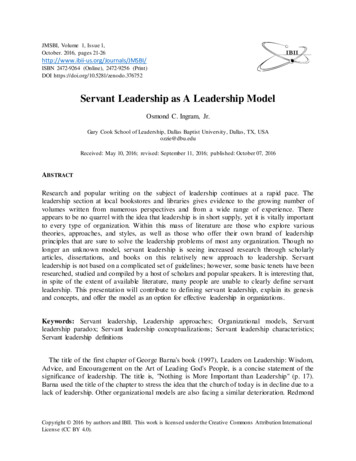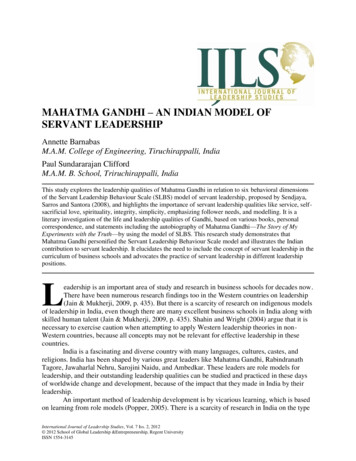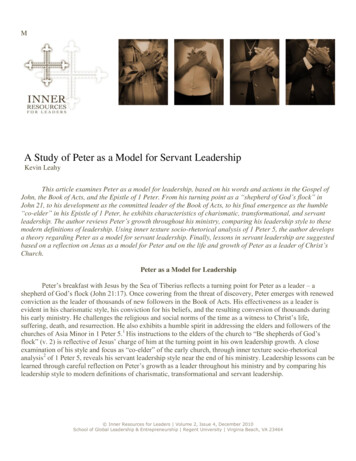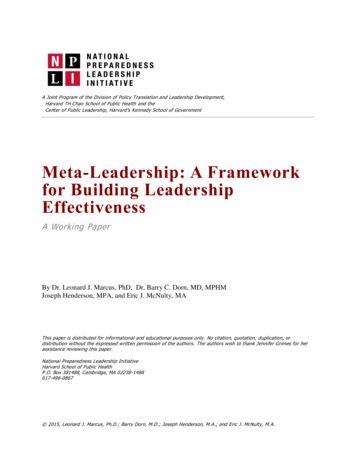
Transcription
JMSBI, Volume 1, Issue 1,October. 2016, pages 21-26http://www.ibii-us.org/Journals/JMSBI/ISBN 2472-9264 (Online), 2472-9256 (Print)DOI https://doi.org/10.5281/zenodo.376752Servant Leadership as A Leadership ModelOsmond C. Ingram, Jr.Gary Cook School of Leadership, Dallas Baptist University, Dallas, TX, USAozzie@dbu.eduReceived: May 10, 2016; revised: September 11, 2016; published: October 07, 2016ABSTRACTResearch and popular writing on the subject of leadership continues at a rapid pace. Theleadership section at local bookstores and libraries gives evidence to the growing number ofvolumes written from numerous perspectives and from a wide range of experience. Thereappears to be no quarrel with the idea that leadership is in short supply, yet it is vitally importantto every type of organization. Within this mass of literature are those who explore varioustheories, approaches, and styles, as well as those who offer their own brand of leadershipprinciples that are sure to solve the leadership problems of most any organization. Though nolonger an unknown model, servant leadership is seeing increased research through scholarlyarticles, dissertations, and books on this relatively new approach to leadership. Servantleadership is not based on a complicated set of guidelines; however, some basic tenets have beenresearched, studied and compiled by a host of scholars and popular speakers. It is interesting that,in spite of the extent of available literature, many people are unable to clearly define servantleadership. This presentation will contribute to defining servant leadership, explain its genesisand concepts, and offer the model as an option for effective leadership in organizations.Keywords: Servant leadership, Leadership approaches; Organizational models, Servantleadership paradox; Servant leadership conceptualizations; Servant leadership characteristics;Servant leadership definitionsThe title of the first chapter of George Barna's book (1997), Leaders on Leadership: Wisdom,Advice, and Encouragement on the Art of Leading God's People, is a concise statement of thesignificance of leadership. The title is, "Nothing is More Important than Leadership" (p. 17).Barna used the title of the chapter to stress the idea that the church of today is in decline due to alack of leadership. Other organizational models are also facing a similar deterioration. RedmondCopyright 2016 by authors and IBII. This work is licensed under the Creative Commons Attribution InternationalLicense (CC BY 4.0).
22O. Ingram / Journal of Management Science and Business Intelligence 2016 1(1) 21-26proposed that “needs of people would be met easier and more efficiently and with less„management‟ if there were more leaders seeking to serve others” (Redmond, 1995, p. 30).This paper will examine servant leadership from a variety of viewpoints. The volume ofresearch into servant leadership as a viable model of leadership is increasing each year. Servantleadership is a relatively popular topic for many dissertations in a variety of fields. It is alsointeresting to consider servant leadership in comparison with other, more established, leadershipmodels. Numerous research studies have focused on such relationships between theories.Servant leadership is often associated with Christian leadership and Christian leaders;however, the model is not limited to the Christian realm. Such well-known organizations as 7Eleven, TD Industries, Southwest Airlines, Herman Miller, and ServiceMaster embrace theservant leadership model. Herman Miller‟s website explains the notion of servant leadership:At Herman Miller, we respect each other as we are and focus on who we will become. Ourculture represents the collective attitudes, aspirations, ideas, and experiences of the people whowork here (http://www.hermanmiller.com/about-us/things-that- matter-to-us.html).A review of Herman Miller‟s values gives further evidence of the company‟s focus on servantleadership. The identified values are operational excellence; better world report; environmentaladvocacy; inclusiveness and diversity; health and well-being; and community service.1. DEFINITIONS AND DEVELOPMENT OF SERVANT LEADERSHIPUnderstanding servant leadership is greatly aided by understanding the terms servant andservice. The dictionary definitions of servant have many dimensions:1.one who serves, or does services, voluntarily or on compulsion; a person who isemployed by another for menial offices, or for other labor, and is subject to his command; aperson who labors or exerts himself for the benefit of another, his master or employer; asubordinate helper2.a person in the service of another3.one who expresses submission, recognizance, or debt to another4.a person working in the service of another5.in a subordinate position6.a person who is hired to work for anotherLikewise, the definitions of the word service take several approaches:1.An act of assistance or benefit; a favor2.an act of helpful activity; help; aid.3.work done by one person or group that benefits another4.The performance of work or duties for a superior or as a servant5.be of service, to be helpful or useful (Dictionary, 2011)The concept of servant leadership, as developed by Robert Greenleaf, has given attention tothe topic of servant leadership. The leader as a servant has historical origins back to biblicaldays, though this has not been a concept understood or practiced by many. Greenleaf'sconception of servant leadership has brought about significant change in the philosophy ofleadership and management in numerous arenas of the secular business world. In describing thequalities of a leader, DePree insisted, “Above all, leadership is a position of servanthood” (1997,p. 220).
23O. Ingram / Journal of Management Science and Business Intelligence 2016 1(1) 21-26There is no one better to define servant leadership than Robert Greenleaf himself. InThe Servant as Leader, Greenleaf (1991) described the servant leaders in this manner, “Theservant leader is servant first It begins with the natural feeling that one wants to serve first.Then conscious choice brings one to aspire to lead” (p. 7). For Greenleaf, “servant leadershipmeans serving others and placing the good of others and the organization above the leader's selfinterest” (Banks & Ledbetter, 2004, p. 108).2 DIMENSIONS, CONCEPTUALIZATIONS, AND PARADOX OF SERVANTLEADERSHIPGreenleaf's servant leadership concept has infiltrated a significant number of management andleadership sectors. A transformation is experienced by many after learning of the servantapproach to leadership. There is a sense in which the servant leader is given permission to serveand meet the needs of others. Though often in practice in secular business settings, servantleadership also brings a spiritual dimension to management and leadership (Rieser, 1995). Forsome, the spiritual side of servant leadership is part of its appeal, especially when examined inthe context of more prevailing societal trends. Even in some business environments, spiritual andreligious discussions have a level of acceptance and do not necessarily create animosity amongcoworkers (Lee & Zemke 1993).Most leadership models can be observed in the workplace and then explained in behavioralterms. Servant leadership differs from other models in that servant leadership comes from withinthe leader, surfacing out of the leader's principles, values, and beliefs. The servant leader'smotivation and behavior come exclusively from the personal principles, values, and beliefs of theleader. It is through service to others that the servant leader seeks to achieve organizational goals(Farling, Stone, & Winston, 1999).The conceptualizations of servant leadership are extremely varied. People who have beenexposed to the idea of servant leadership might describe the model in any number of ways.Research on servant leadership includes several attempts to conceptualize the term. The conceptof servant leadership finds its roots as far back in history as 600 B.C. At about this time, aChinese Philosopher Lao Tzu expressed his idea about servant leadership by writing that thegreatest leader forgets himself and attends to the development of others (Lichtenwalner, 2011).Biblical concepts of servant leadership are described in many passages of Scripture, though noneof these passages are noted with the term “servant leadership.”Robert Greenleaf gave much attention to the conceptualization of servant leadership in hiswritings. Larry Spears (2004), former president of the Greenleaf Center for Servant Leadership,offered many explanations of ten of Greenleaf's most prominent characteristics that enhance anunderstanding of the concept of servant leadership. Spears‟ list of characteristics includedlistening, empathy, healing, awareness, persuasion, conceptualization, foresight, stewardship,commitment to the growth of people, and building community.Laub (1999) identified six scales of servant leadership that can provide a comprehensivemodel within which to identify specific characterizations. Many of the elements of Laub's scalesare consistent with those identified by Greenleaf and those writings based on Gre enleaf's model.The categories suggested by Laub are values people, develops people, builds community,displays authenticity, provides leadership, and shares leadership (Laub, p. 83).Servant leadership is not an oxymoron; however, it is a paradox. The ent ire principle ofServant leadership was developed in the framework of Greenleaf's notion that the sole reason forthe leader's existence is to serve the followers. As Lee explained, “It does stand the traditional
24O. Ingram / Journal of Management Science and Business Intelligence 2016 1(1) 21-26view of the leader—the CEO at the peak of the pyramid, the captain at the helm of the ship—onits head” (Lee & Zemke, 1993, p. 28). Servant leadership is dependent upon the blending ofbeing a leader and being a servant. Servant leadership is not a concept of either/or; instead, theconcept is both/and. “In the end, being a servant leader is not something you do but rathersomething you are” (DeGraaf, et al, 2001, p. 27).3 SERVANT LEADERS: BORN OR MADE?Gardner made a dogmatic statement about the prospect of leaders being born or made. Whenthe question of servant leaders being born or made was rephrased to ask if servant leadership canbe taught, Gardner (1990) gave another dogmatic answer—yes! He found that it is reasonable tobelieve that servant leadership can be taught because leadership itself can be taught. Servantleadership includes many of the same elements found in leadership.Other researchers are not as quick to agree to an answer to this prevalent question. Rost (1991)suggested that a number of leadership concepts make the assumption that leaders are made, notborn, but he pointed out that this could be too narrow a view. Maintaining such a stance does notconsider the growth process of the leader. Ndoria (2004) stressed that there is much to be learnedby studying the application of the various theories and approaches to leadership. She offered anexample regarding transformational leadership.Servant leadership recognizes awareness as a key mechanism for leadership development.Considering the development of servant leaders, Greenleaf (1970) suggested that “awareness . . .strengthens one's effectiveness as a leader.” The sign of an effective servant leader is whether ornot the community the leader serves becomes “healthier, wiser, [and] freer.” Greenleaf alsonoted that leaders must learn how to view the act of leading as an act of serving followers(Greenleaf, p. 27).4 MODEL COMPARISONComparison of varied models of servant leadership contributes to a more completeunderstanding of a conceptualization of servant leadership adaptable for the higher educationenvironment. It should be noted that the conceptualizations of servant leadership are closely akinto traits, characteristics, and behaviors. In particular, a comparison of varied conceptualizationsmay serve as a fundamental basis for the development of a research instrument for use in thehigher education setting.Laub's six scales—values people, develops people, builds community, displays authenticity,provides leadership, and shares leadership—can be viewed as they relate to the characteristicsforming the conceptualizations of servant leadership in the models described by Greenleaf,Spears, Farling, Stone, Winston, and Ingram.The conceptualizations of servant leadership examined are not specific to higher education;however, one could argue for adoption of such characteristics among educators andadministrations in the higher education setting.Table 1 displays the comparison of five servant leadership models.Table 1. Servant Leadership Model ComparisonGreenleafLaubSpearsHealingServiceValues peopleDevelopsHealingGrowth ofFarling, Stone, andWinstonTrustServiceIngramAcceptanceRelationship
25O. Ingram / Journal of Management Science and Business Intelligence 2016 1(1) 21-26Ability to leadInfluenceLanguage steningPersuasionStewardshipConceptualizing5 CONCLUSIONUnderstanding servant leadership is only the first step toward the practice of servantleadership. Today‟s service economy is consistent with servant leadership, but the concept takesservice to a higher level. Students today are increasingly seeing themselves as consumers andcustomers—people who seek a service that higher education offers. Educators have theopportunity to meet the needs of students by teaching the disciplines in which they are expertsand model for students a viable leadership example that can further prepare them for theirvocational choices.REFERENCES[1] Banks, R., & Ledbetter, B. (2004). Reviewing leadership: A Christian evaluation of currentapproaches. Grand Rapids, MI: Baker Academic.[2] Barna, G. (1997). Leaders on leadership. Ventura, CA: Regal Books.[3] DeGraaf, D, Tilley, C., & Neal, L. (2001). Servant leadership characteristics inorganizational life. Indianapolis, IN: The Robert K. Greenleaf Center.[4] DePree, M. (1997). Leading without power: Finding hope in serving community. Holland, MI.Shepherd Foundation.[5] Farling, M., Stone, A., & Winston, B. (1999, WinterSpring). Servant leadership: Setting thestage for empirical research. Journal for Leadership Studies 6(1/2), 4972.
26O. Ingram / Journal of Management Science and Business Intelligence 2016 1(1) 21-26[6] Gardner, J. (1990). On leadership. New York, NY: Free Press.[7] Greenleaf, R. (1970). The servant as leader. Indianapolis, IN: The Robert Greenleaf Center.[8] Greenleaf, R. (1991). The servant as leader. Indianapolis, IN: The Robert K. GreenleafCenter.[9] Ingram, O. (2003). The conceptualization and perception of servant leadership in Christianhigher education. (Doctoral dissertation). Louisville, KY: Southern Baptist TheologicalSeminary.[10] Laub, J. (1999). Assessing the servant organization: Development of the servantorganizational Leadership assessment instrument. (Unpublished doctoral dissertation). FloridaAtlantic University, Boca Raton, FL.[11] Lee, C., & Zemke, R. (1993). The search for spirit in the workplace. Training. 6(6), 2129.[12] Lichtenwalner, B. (2011). Resources for the beginning servant leader. Retrieved rcesforthebeginningservantleader/[13] Miller, Herman (n.d.) Things that matter to us. Retrieved at- matter-to- us.html[14] Ndoria, J. (2004). Servant leadership: A natural inclination or a taught behavior. ServantLeadership Research Rountable. Virginia Beach, VA: Regent University.[15] Redmond, B. (1995). Biblical foundations for developing a servant mindset. (Unpublishedmaster's thesis). Moody Bible Institute, Chicago, IL.[16] Rieser, C. (1995). Claiming servantleadership as your heritage. In L. Spears (Ed.),Reflections on leadership: How Robert K. Greenleaf's theory of servant leadership influencedtoday's top management thinkers (pp. 4960). New York, NY: John Wiley & Sons.[17] Rost, J. (1991). Leadership for the twentyfirst century. New York, NY: Praeger.[18] Servant. (2011). In Dictionary.com. Retrieved [19] Spears, L. (2004). Practicing servant leadership: Succeeding through trust, bravery, andforgiveness. San Francisco, CA: JosseyBass.
leadership and management in numerous arenas of the secular business world. In describing the qualities of a leader, DePree insisted, “Above all, leadership is a position of servanthood” (1997, p. 220). 23 O. Ingram / Journal of Man











